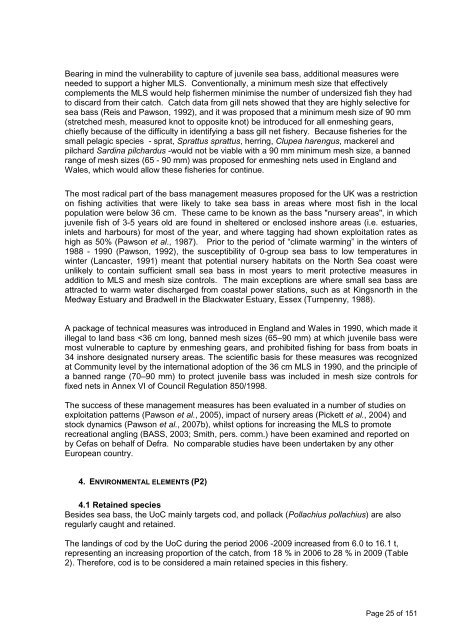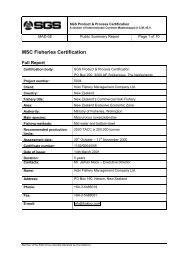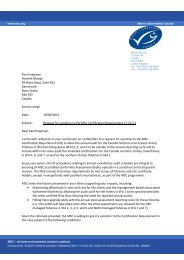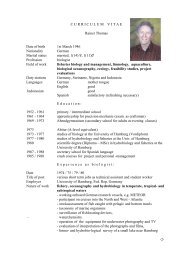SGS Product & Process Certification - Marine Stewardship Council
SGS Product & Process Certification - Marine Stewardship Council
SGS Product & Process Certification - Marine Stewardship Council
Create successful ePaper yourself
Turn your PDF publications into a flip-book with our unique Google optimized e-Paper software.
Bearing in mind the vulnerability to capture of juvenile sea bass, additional measures were<br />
needed to support a higher MLS. Conventionally, a minimum mesh size that effectively<br />
complements the MLS would help fishermen minimise the number of undersized fish they had<br />
to discard from their catch. Catch data from gill nets showed that they are highly selective for<br />
sea bass (Reis and Pawson, 1992), and it was proposed that a minimum mesh size of 90 mm<br />
(stretched mesh, measured knot to opposite knot) be introduced for all enmeshing gears,<br />
chiefly because of the difficulty in identifying a bass gill net fishery. Because fisheries for the<br />
small pelagic species - sprat, Sprattus sprattus, herring, Clupea harengus, mackerel and<br />
pilchard Sardina pilchardus -would not be viable with a 90 mm minimum mesh size, a banned<br />
range of mesh sizes (65 - 90 mm) was proposed for enmeshing nets used in England and<br />
Wales, which would allow these fisheries for continue.<br />
The most radical part of the bass management measures proposed for the UK was a restriction<br />
on fishing activities that were likely to take sea bass in areas where most fish in the local<br />
population were below 36 cm. These came to be known as the bass "nursery areas", in which<br />
juvenile fish of 3-5 years old are found in sheltered or enclosed inshore areas (i.e. estuaries,<br />
inlets and harbours) for most of the year, and where tagging had shown exploitation rates as<br />
high as 50% (Pawson et al., 1987). Prior to the period of ―climate warming‖ in the winters of<br />
1988 - 1990 (Pawson, 1992), the susceptibility of 0-group sea bass to low temperatures in<br />
winter (Lancaster, 1991) meant that potential nursery habitats on the North Sea coast were<br />
unlikely to contain sufficient small sea bass in most years to merit protective measures in<br />
addition to MLS and mesh size controls. The main exceptions are where small sea bass are<br />
attracted to warm water discharged from coastal power stations, such as at Kingsnorth in the<br />
Medway Estuary and Bradwell in the Blackwater Estuary, Essex (Turnpenny, 1988).<br />
A package of technical measures was introduced in England and Wales in 1990, which made it<br />
illegal to land bass





